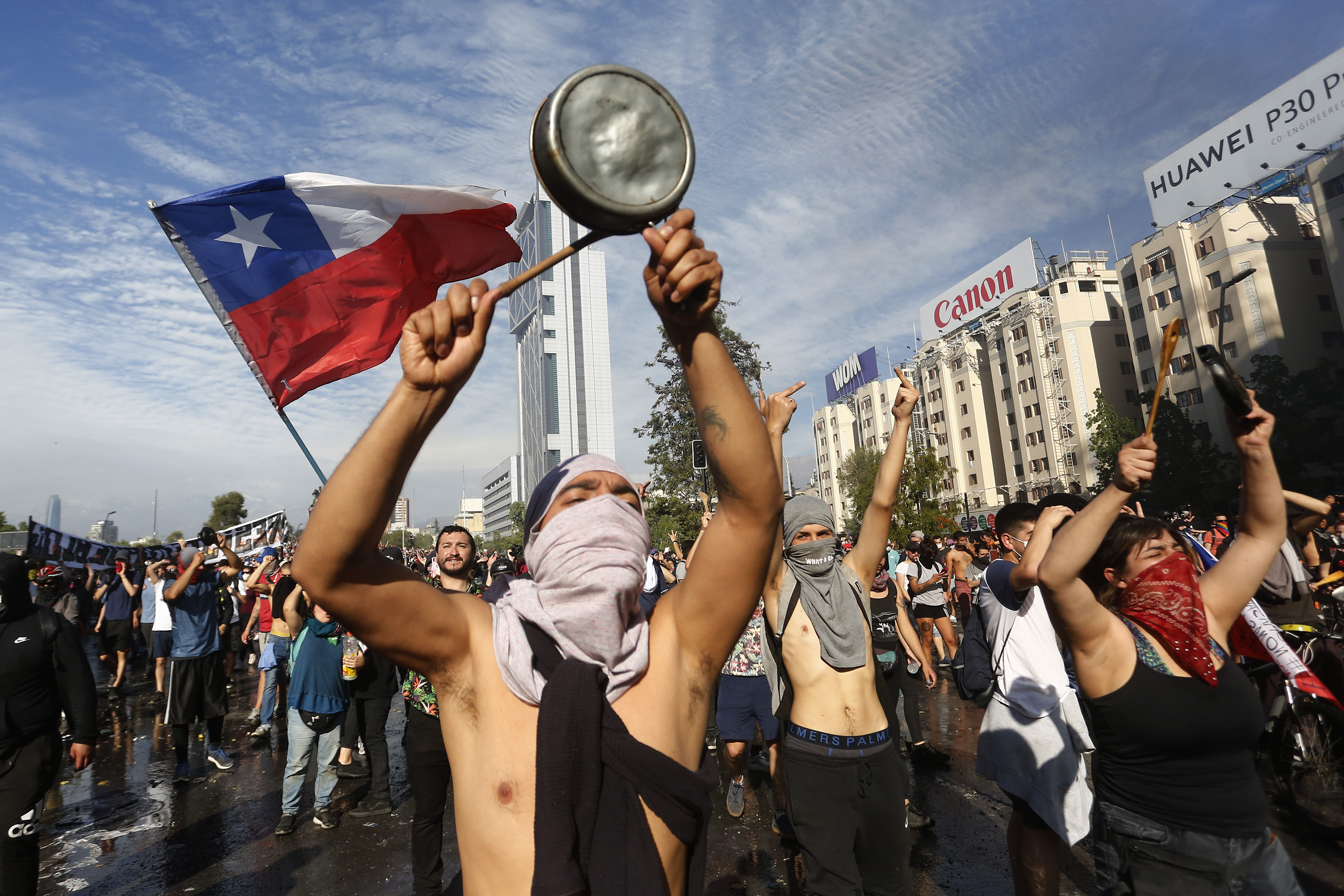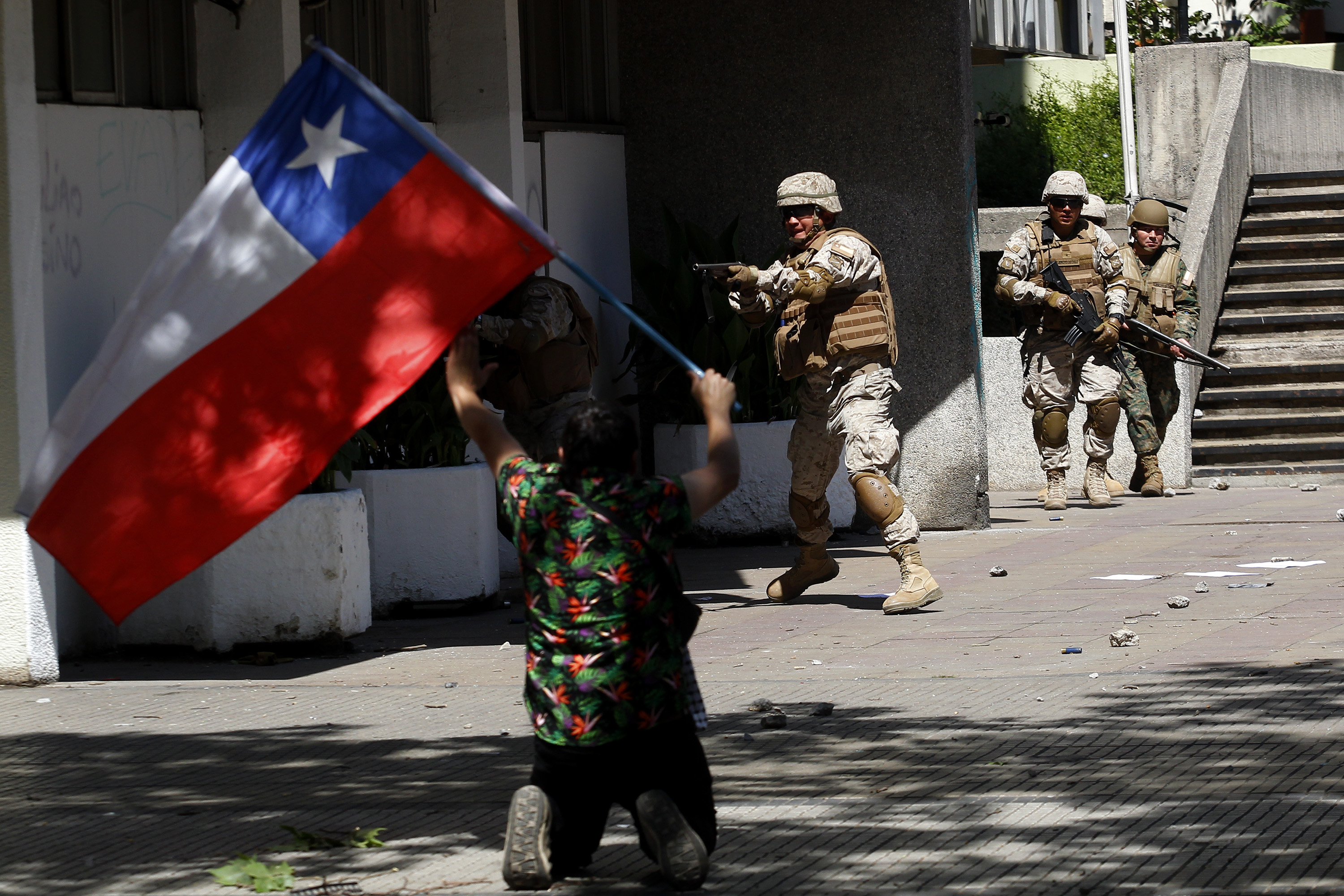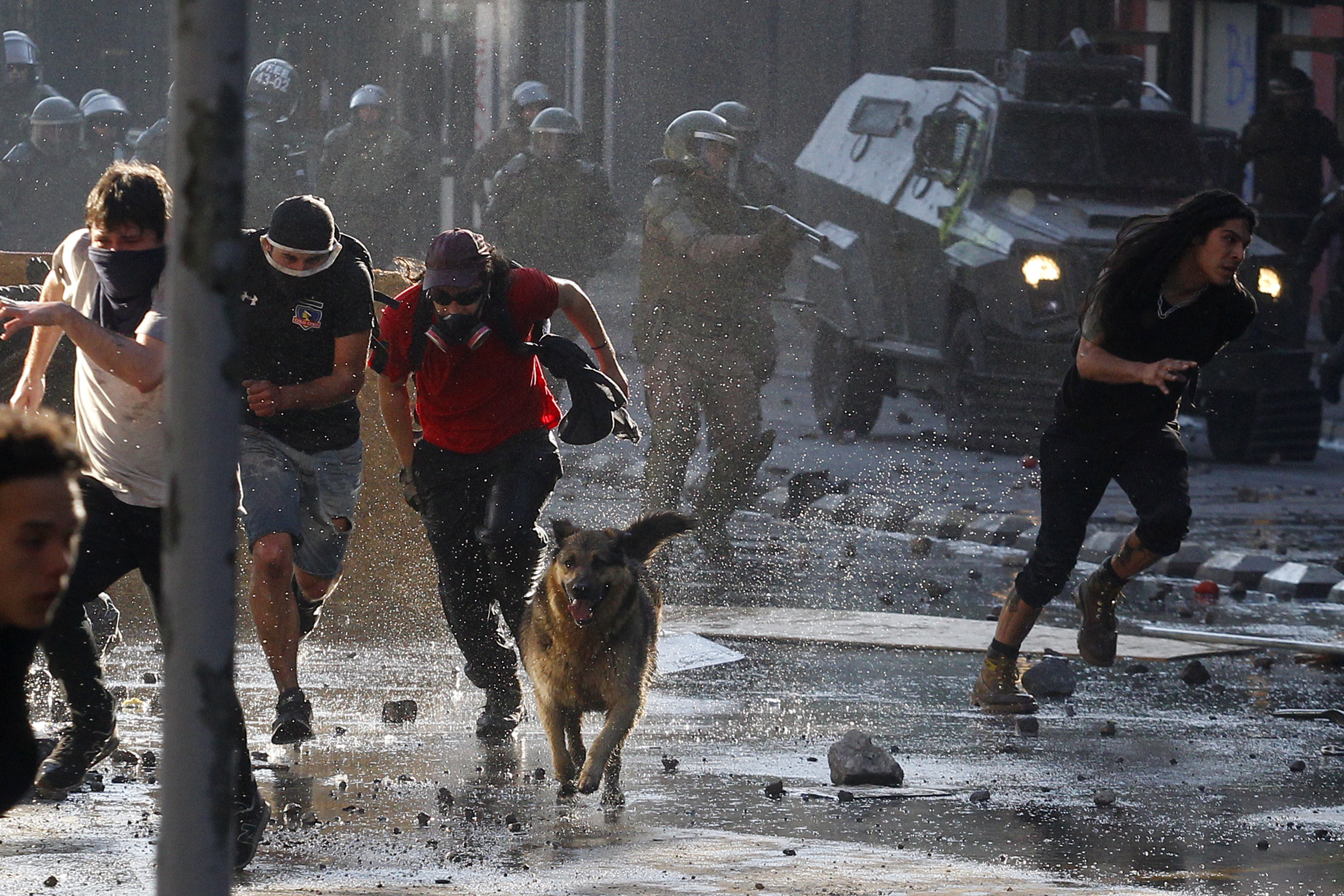Social commotion has taken over the streets of Chile. On October 17, high school students called on Chileans to stop paying the fare to use public transportation; and in Santiago, the South American country’s capital, many followed suit. They were demonstrating against an increase in metro ticket prices, but soon, what started as a fare-dodging protest, turned into social disobedience. Subway station gates were forced open. Fires cracked. About 500 million pesos, or $703,500, worth of damage was done. That day, 133 people were arrested. The next day, as subway stations remained closed, Chilean President Sebastián Piñera declared a state of emergency and ordered the military to take over the streets. By the weekend, a curfew, the signature measure of Chilean dictator Augusto Pinochet, was imposed.
For a week, crowds of tens of thousands of people have swelled streets throughout the country. Ignited by the since-reversed subway fare hike, they are now demonstrating against economic inequality brought on by neoliberal policies made over the last three decades. The increase in metro fees made evident, for instance, the rising costs of privatized basic utilities, like water, highways and the pension system, all while wages stagnate. In one of Latin America’s wealthiest nations, the people have united en mass to object its economic inequality.
“No son 30 pesos, son 30 años,” is a chant commonly heard at peaceful protests around the nation that capture the feeling of the people. Many are now calling on Piñera’s resignation, as he has been a major player in the social and economic changes imposed by Pinochet’s regime.

In response, on Sunday, the president stated that he is “at war with a powerful, relentless enemy” — specifically, those who are calling for his removal. Since then, high school and university student leaders have been taken from their homes and safe houses during curfew, 18 people have died, more than 200 individuals have been wounded, some 5,000 have been arrested, many are missing after being taken into custody, reports of sexual abuse toward young women has risen and videos showing the military engaged in actions eerily similar to torture are being posted to social media almost-hourly.
Pressured by the Chilean people, Piñera apologized for “lack of vision” and accumulated problems as well as announced a new social and economic agenda on Tuesday. He promised social and economic reform, including pension raises, affordable medical insurance, lowering the prices of medicines and stabilizing electricity prices. While asking for the public’s forgiveness, he did not take steps to end the state-sponsored violence. Instead, he said there would be a fast-track justice system for the victims of vandalism and a quick reconstruction of public services they destroyed. Some 20,000 soldiers continue to patrol the streets.
While mainstream media has largely focused on looting as well as damage to public and private property, videos that capture the brutal police and military violence against Chilean demonstrators have been circulating on Twitter, Facebook, Instagram and WhatsApp. They show, on the one hand, the celebratory effusion at pacific, family-friendly protests, and, on the other, the use of excessive and unjustified use of violence from the military and the police toward Chileans. As in the days of the Pinochet dictatorship, security has been used as an excuse for the abuse of power by men in uniform.
“We are brave, but we are defenseless. Blood is flowing and it is tainting the streets.”
With massive protests carrying on in its seventh day, Chilean demonstrators, including poets, journalists, educators and artists, share what they have witnessed on the streets. For some, it’s a spirit of resiliency that inspires hope. For others, it’s state-sanctioned brutality that they never imagined they’d see in Chile again.
Responses have been edited for length and clarity.
Victoria Herreros, Valparaíso, Chile
My experience in the protests has been brutal. The first day in Valparaíso, before the military arrived, there was no police force that could repress the people, so the curfew started 45 minutes earlier. When the military arrived, there was still a lot of people on the streets, and they were brutally beaten. On Monday, my city was like an uneven battle field. We’ve learned about deaths in several parts of the country. People have been wounded and women have been raped. Piñera’s dictatorship is getting more and more violent and appearing more similar to that of Pinochet’s. Piñera’s declaration of war has meant that the military are shooting at people who are only armed with pots and pans. Democracy? We still live under the Constitution of the Dictator. The armed forces are unleashed. They are not following any rational protocol, and we have seen many videos of torture and abuse. It is time that the people recover democracy for ourselves, but we need the intervention of international groups. We are brave, but we are defenseless. Blood is flowing and it is tainting the streets.
Naomi Orellana, Santiago, Chile

The general feeling is of confusion and contradiction. People are all very united. Everybody knows exactly what we are asking for, and that is really impressive. I have never seen or felt this before. As an activist and a feminist, I see that the movement is mature and growing. Everyone has recovered the sense of community. People are gathering and taking care of each other. On the other hand, there are milicos everywhere. I see them standing in the corner of my street and in the subway station. At night, things start to get ugly. There is a moment right after curfew when people are still protesting with cacerolas, resisting the curfew, and that is beautiful and courageous. But we know that things in the poblaciones are way uglier and dangerous. There, anything can happen. These days, you can see the most beautiful things and the most horrible. Yesterday, somebody found a dead body hanging from some bars. There are videos showing how the milicos incite the saqueos, and then close off people inside to blame them. There are people in custody. Others have disappeared. We are repeating history, and many people are reliving their traumas. At the same time, nothing is as it was. For example, everybody is walking, because there is no public transportation. All the streets have been flooded with graffiti against authority and buildings have broken windows. For me, it feels like we were just sleeping and suddenly we all woke up to a different reality.
Daniela*, Posta Central in Santiago
We arrived at the Posta Central in Santiago on Oct. 22 at around 7:30 p.m. because a friend had been shot seven times and was in very serious condition. When we got there, we crossed paths with a young man who was entering the building in a wheelchair. He was brought in by a friend because he was in really, really bad condition. He told us that the police had taken them into the Baquedano subway station and hit him with wet towels all over his body. Then, they covered him in cloths and hit him with their sticks, later tying him up and torturing him. I am not sure how he was able to escape. We couldn’t talk with him much. He was in shock and crying. He had seen three dead bodies lying down there. A friend later told me she kept hearing the young man scream in the emergency room, saying that he was tortured and sharing what he had seen. After we spoke, I listened in disbelief that the Instituto Nacional de Derechos Humanos (INDH), an organization who has been keeping records and filing suits, confirmed that a centro de tortura had been created in the Baquedano subway station.
“We are repeating history, and many people are reliving their traumas.”
Alejandra Castillo, feminist philosopher, Santiago:
I have lived these days in the vertiginous, accelerated time of radical protest. It was initiated by the motto “evadir, no pagar, otra forma de luchar” created by high school students to motivate people to rebel against the surge in subway fares. But this specific protest puts in evidence two things. First, the weight of living in a neoliberal order, where the majority, who are getting poorer and living in extremely bad conditions, are making formerly unheard demands for public health, education, pensions and worker precarity. The other scene is of the right-wing, neoliberal government that has responded to the demands by imposing a state of emergency, a curfew and unleashing the military to violently control and repress the Chilean people. I thought I would never hear those words again, “toque de queda.” I thought I would never again see the military on the streets hitting and detaining protesters, without due process, even murdering them. The horror of times past looms into everyday life.
Javier Candia Neira, Antofagasta:
In Antofagasta, police repression has been brutal. During the state of emergency and the curfew, there have been many abnormal situations. For example, on Saturday, when the protests started, 13 people were arrested. Those arrests were declared illegal by the Ministerio Público, which is in charge of the justice system. Nevertheless, police denied to free them. Only after midnight, Óscar Clavería, the judge of the court of appeals, was able to get into the police station and demand their freedom. Even one of the municipal leaders said she had been tortured in that police station. These have been dramatic days for everybody, where police and the military march down the streets, acting as if they are at war. Helicopters that are surveying the city fly close to the ground, generating panic among the protesters. As lootings occur, officers and military personnel aren’t stopping them. They allow people to steal as they violently repress the protesters, who demonstrate pacifically. Right now, I am with thousands of people protesting for a third day in a row in downtown Antofagasta.

Carmen Avendaño, Viña del Mar, Chile
The boots that we hadn’t seen since the days of the Pinochet dictatorship stomp through the streets. Everything is tense after the curfew. In the morning, the city seems to be functioning normally. Protests are set to start at noon, but at 11:30 a.m. a woman ran down the main street beating her cacerola as if she wanted to wake everybody up. These last few days, the news media has shared images of looting. What we don’t see is that those taking goods are often hungry or in debt. Others are soldiers and police officers. What we don’t see are the videos, more likely to be circulated on social media, of soldiers shooting, snorting cocaine and coordinating lootings, while elderly women and children run away from the bullets. The year started with demonstrations against the police killing of Mapuche community leader Camilo Catrillanca, against the growing rates of femicide and for environmental justice. The government acts as if it is deaf. Instead, they enacted a law called “Aula Segura” to intervene in high schools where students were organizing. Nevertheless, students rose. It’s hard to tell what started it all, but maybe the protest youth led in subways will end up in Congress. Protesters were treated like criminals by the Interior Minister Andrés Chadwick, who in his younger years walked beside Augusto Pinochet. The nightmare of the dictatorship and the promise of popular solidarity mark my experience as a chaotic ciaroscuro, enlightened, but also manipulated cybenetic web of information. For me, it feels like a clash of times, the end of patience and the sound of a corazón de cacerola.







